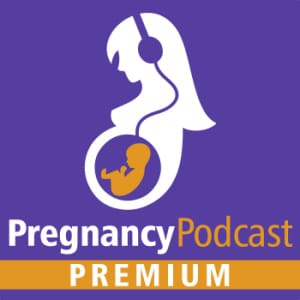Welcome to week 32. Only eight weeks to go!
Listen Now
Baby
Your asparagus-sized baby is growing to about the size of a cantaloupe. Your baby measures 16.9 inches (43 cm) and weighs 4.3 pounds (2 kg).
Your typically energetic baby may start to chill out a little bit. Their movements may feel more like squirms and rolls rather than hyperactive kicking. This is because they have less room to stretch out and move around. They will gain a third to half of their birth weight during the next seven weeks in preparation for life outside the womb. Their digestive tract is almost fully developed and will be ready to digest milk once they are born.
By week 32, your baby could detect a stroke of a feather. Early in pregnancy, babies move away from touch. As they grow, they will respond by moving toward touch. One study showed that babies responded to touch more than voice by moving their heads, arms, hands, or mouth. You can apply touch by gently stroking your belly or massaging your stomach with light pressure. See this episode for more ways to bond with your baby during pregnancy.
Mom
Your uterus rises five inches higher than your belly button and is still expanding. Since you became pregnant, your blood volume has increased 40 to 50 percent to accommodate you and your baby’s growing needs.
If a question about fetal health and well-being comes from an examination, symptoms, or your pregnancy is a high risk, your care provider may recommend a biophysical profile. This is a test to determine fetal health that can take place after 32 weeks. This combines an ultrasound with a non-stress test where belts around your belly measure fetal heart rate and contractions.
Ideally, your baby is positioned head-down before birth, facing your back, with their chin tucked to their chest and the back of their head ready to enter your pelvis. This is called cephalic presentation, and most babies settle into this position within weeks 32-36. If your baby is currently breech, it is an excellent time to talk to your care provider about interventions to try and turn them and the optimal time frame to employ any interventions.
An external cephalic version is a procedure in which your doctor or midwife puts pressure on the outside of your belly to try and get your baby to turn head down. The American College of Obstetricians and Gynecologists states that the preferred time for an ECV is after 37 weeks. Research shows an earlier ECV (32-34 weeks) increases the chances that your baby will be lying head down at full term. You can listen to this episode for more evidence on breech babies and an external cephalic version. Many mothers also swear by Spinning Babies, and you can learn about the evidence of this method in the episode on optimal fetal positioning and spinning babies.
There are claims that the Louwen diet makes your labor easier, creates a smaller baby, and results in a less painful birth. This diet restricts high glycemic foods from week 32 until birth. See this episode for an examination of the evidence on this diet and others during pregnancy.
After your baby is born, you have one last stage of labor to birth your placenta. As with everything related to birth, you have options for the third stage. Expectant management is without interventions, and active management can involve medications and some physical interventions. Advocates of expectant management argue that the natural process your body goes through promotes normal separation and birth of the placenta and minimizes complications. Proponents of an active approach argue that active management is quicker and results in fewer complications. Which is the better approach? For a breakdown of your options and the evidence, see the episode on the third stage of labor.
Tip for Dads and Partners
Back in the 1950s, dads spent labor in hospital waiting rooms, called “stork clubs,” until a nurse came in to tell them they were a father. Today, dads and partners are active participants, from planning during pregnancy to catching their babies at birth. Get on the same page with mom about the role they want you to play during labor. If you need help, there is an episode on preparing your partner for birth that breaks down labor step-by-step and details what you should be doing at each stage of labor.
Thank you to 8 Sheep Organics for supporting this episode and helping power the 40 Weeks Podcast.

Save 10% on 8 Sheep Organics
The True Belly Serum from 8 Sheep Organics is specially formulated with clinically proven ingredients that penetrate deep into the skin to effectively prevent stretch marks. Like all 8 Sheep products, the True Belly Serum comes with a 100-day Happiness Guarantee. You can try it completely risk-free for 100 days! Click here to save 10%.
Want more evidence-based information to navigate your pregnancy and birth?

20% OFF Pregnancy Podcast Premium with the code 40WEEKS. With a Premium membership, you get access to the private podcast feed (in your favorite podcast app) with every episode ad-free. Exclusive access to all episodes, articles, and resources on the website. Plus, a digital copy of the Your Birth Plan book. Your step-by-step guide to creating the birth experience you want. Including sample plans and a master template you can customize. Become a Pregnancy Podcast Premium Member.
